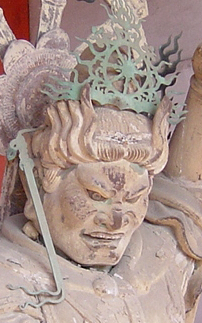 Illusion news 9
Illusion news 9 
 Illusion news 9
Illusion news 9 
since February 19, 2008
<Pictures: guardian statues in the Ninna-ji temple>
Visiome Platform is a digital research resource archive for vision science. The available resources include mathematical models, experimental stimuli, experimental data, and analytical tools. See my catalogue page. <April 26, 2008>
For example, if you need a high-resolution image of , click
, click  . Then, a 4554 x 8000 pixel bitmap can be downloaded.
. Then, a 4554 x 8000 pixel bitmap can be downloaded.
I have received a letter from one of my greatest fans in Belgium! Click
here (PDF) (removed on request on January 19, 2023).
<April 18, 2008>
Thanks to Vianney & Bruno
------------------------
Related works
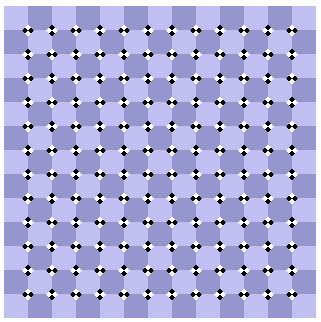
"Men with sunglasses"
Vertical or horizontal edges appear to be distorted and each quarter region appears to move.
Copyright A.Kitaoka 2000

Elemental
images
(copyright free; citation is
necessary)
The horizontal edge in the middle of each image appears to tilt counterclockwise. This illusion was proposed by Kitaoka, Pinna and Brelstaff (2001, 2004).
References
Kitaoka, A., Pinna, B., and Brelstaff, G.
(2001). New variations of spiral illusions. Perception, 30,
637-646. ![]()
Kitaoka, A., Pinna, B., and Brelstaff, G.
(2004). Contrast polarities determine the direction of Cafe Wall tilts.
Perception, 33, 11-20. ![]()
Kitaoka, A. (2007) Tilt illusions after Oyama
(1960): A review. Japanese Psychological Research, 49, 7-19. ![]() PDF
PDF


The elemental image of
primrose's version
(copyright free;
citation is necessary)

"Noshi"*
*kind of decorations for cerebration
Inner gold squares appear to tilt counterclockwise.
Copyright Akiyoshi Kitaoka 2005 (2/14)

"Turtles"
Vertical or horizontal edges appear to tilt.
Copyright A.Kitaoka 1999

"Cultured turtles"
Vertical or horizontal edges appear to be distorted.
Copyright A.Kitaoka 2002

"Primrose's field"
This checkered background consists of squares but appears to wave. In addition, this figure shows a great amount of anomalous motion illusion.
Copyright A.Kitaoka 2002
The 3rd Imai Award for Research on Optical Illusions was given to Professor Shin Nozawa for his study on the figural aftereffect and Professor Koraro Suzuki for his contribution to the moon illusion. Related webpage (in Japanese) <April 2, 2008>
The relationship between the "Rotating snakes" illusion and age has been examined several times. Here are additional data from participants of my talk given to the students of the Ritsumeikan Keisho Junior High School who visited the Ritsumeikan University. The items for answer were "Rotating snakes appear to move well" (score 3), "Rotating snakes appear to move" (score 2), "Rotating snakes appear to move slightly" (score 1), and "Rotating snakes do not appear to move at all" (score 0). As a result, there was no significant correlation between illusion magnitude and age within these samples. <March 6, 2008>

The six adults were teachers.

Data from students of the Ritsumeikan Keisho Junior High School (March
5, 2008). For scores, see text.
The graph shown below displays the combined data that have been collected
so far. A significant negative correlation (r = -.40) was found between
the Rotating Snakes illusion and age! This does not necessarily mean that
the older the observer is, the less visible the illusion. This indicates
that some unknown characteristics of this illusion are related to age while
this illusion is not related to aging.

For those who do not see the "Rotating snakes" illusion, please do not worry because "no illusion" does not mean anything. It is only one of the individual differences. Please enjoy other illusions!
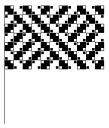 ***DUE TO POPULAR DEMAND*** --
***DUE TO POPULAR DEMAND*** --
The deadline for the 4th Annual Best Visual Illusion of the Year Contest has been extended. FINAL (no exceptions) submission date is now ***March
1st***!
http://illusioncontest.neuralcorrelate.com
Many of the most outstanding illusion creators in the world have asked
us toextend the deadline so as to perfect their contributions for the Contest!
The voters at the 4th Annual Best Illusion of the Year Contest, in Naples,Florida,
will certainly see the Best and Most Exciting New Illusions of the Year.
This award is chosen by the community, and not by a committee, so please
come and make your vote!
The 2008 contest will be hosted by Stuart Anstis and held in Naples, Florida
(Naples Philharmonic Center for the Arts, http://www.thephil.org) on Sunday, May 11th, 2008, during the week of the Vision Sciences Society
conference (VSS). The Naples Philharmonic Center is an 8-minute walk from
the main VSS headquarters hotel in Naples, and is thus central to the VSS
conference.
The 2007 annual contest, held in Sarasota, Florida, drew numerous accolades
from attendees and international media coverage, as well as over *** ONE
MILLION*** website hits from viewers all over the world. The First, Second
and Third Prize winners were Frederick Kingdom, Ali Yoonessi and Elena
Gheorghiu (McGill University, Canada), Pietro Guardini and Luciano Gamberini
(University of Padova, Italy), and Arthur Shapiro and Emily Knight
(Bucknell University, USA). To see the illusions, photo galleries and other
highlights from the 2007 contest, go to http://illusioncontest.neuralcorrelate.com
(which is decorated with the enhanced checkered illusion  ).
).
Visual Illusion Contestants are invited to submit novel visual or multimodal
illusions (unpublished, or published no earlier than 2007) in standard
image, movie or html formats. An international panel of impartial judges
will rate the submissions and narrow them to the TOP TEN. Then, at the
Contest Gala in Naples, the TOP TEN illusionists will present their contributions
and the attendees of the event (that means you!) will vote to pick the
TOP THREE WINNERS!
The renowned sculptor and artist, Guido Moretti, has created three amazing
works of art to serve as trophies for the TOP THREE winners!
See the trophies at: http://illusioncontest.neuralcorrelate.com/index.php?module=pagemaster&PAGE_user_op=view_page&PAGE_id=145&MMN_position=41:41
Illusions submitted to previous editions of the contest can be re-submitted
to the 2008 contest, as long as they meet the above requirements and were
not among the top three winners in previous years.
Submissions will be held in strict confidence by the panel of judges and
the authors/creators will retain full copyright. No illusions will be posted
on the illusion contest's website without the creators' explicit permission.
As with submitting your work to any scientific conference, participating
in the Best Illusion of the Year Contest does not preclude you from also
submitting your work for publication elsewhere.
Submissions can be made to Dr. Susana Martinez-Conde (Illusion Contest
Coordinator, Neural Correlate Society) via email (smart@ neuralcorrelate.com) (remove the space after @) until ***March 01, 2008***. Illusion submissions
should come with a (no more than) one-page description of the illusion
and its theoretical underpinnings (if known). Illusions will be rated according
to:
. Significance to our
understanding of the visual system . Simplicity of the
description . Sheer
beauty . Counterintuitive quality . Spectacularity
Visit the illusion contest website for further information and to see last
year's illusions: http://illusioncontest.neuralcorrelate.com
Submit
your ideas now and take home this prestigious award!
On behalf of the Neural Correlate Society: Susana Martinez-Conde (Illusion
Contest Coordinator)
Neural Correlate Society Executive Committee: Jose-Manuel Alonso, Stephen
Macknik, Luis Martinez, Xoana Troncoso, Peter Tse

The relationship between the "Rotating snakes" illusion and age has been examined several times. Here are additional data from participants of my talk in the Graduate School of Medicine, the University of Tokyo. The items for answer were "Rotating snakes appear to move well" (score 3), "Rotating snakes appear to move" (score 2), "Rotating snakes appear to move slightly" (score 1), and "Rotating snakes do not appear to move at all" (score 0). As a result, there was no significant correlation between illusion magnitude and age within these samples. <February 19, 2008>
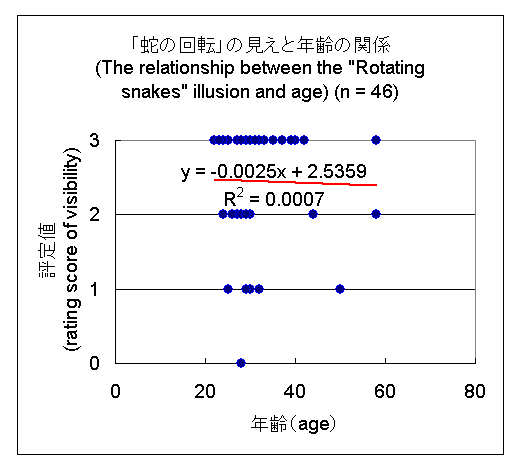
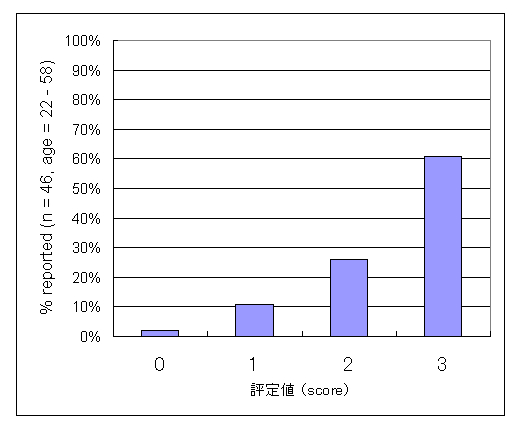
Data from participants of the Shizuoka Science Museum "Ru-ku-ru"
(February 10, 2008). For scores, see text.
The graph shown below displays the combined data that have been collected
so far. A significant negative correlation (r = -.42) was found between
the Rotating Snakes illusion and age! This does not necessarily mean that
the older the observer is, the less visible the illusion. This indicates
that some unknown characteristics of this illusion are related to age while
this illusion is not related to aging.
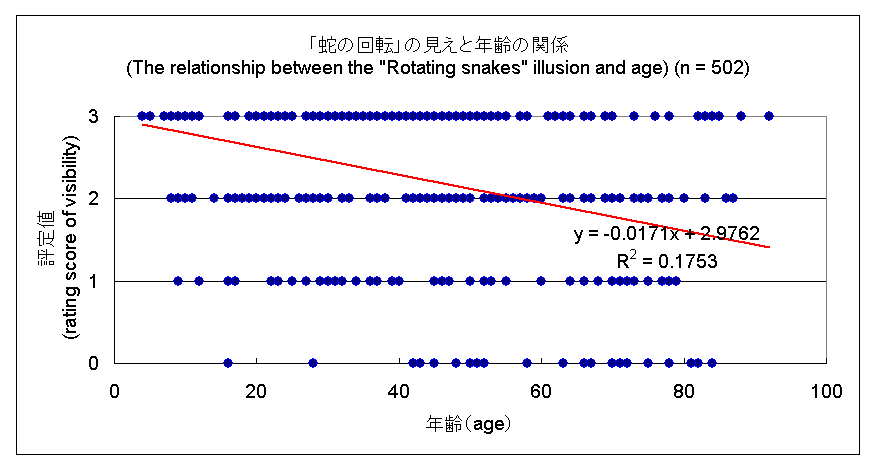
For those who do not see the "Rotating snakes" illusion, please do not worry because "no illusion" does not mean anything. It is only one of the individual differences. Please enjoy other illusions!

"Neural circuits"
The two concentric arrays of stars appear to rotate in the different directions when we approach or move away from the figure while fixating at the center.
Copyright A.Kitaoka 2000
Illusion news 8 (November 2007 - February 2008)
Illusion news 7 (September 2007 - October 2007)
Illusion news 6 (June 2007 - September 2007)
Illusion news 5 (January 2007 - May 2007)
Illusion news 4 (January 2006 - December 2006)
Illusion news 3 (January 2006 - May 2006)
Illusion news 2 (April 2005 - December 2005)
Illusion news 1 (2002 - March 2005)